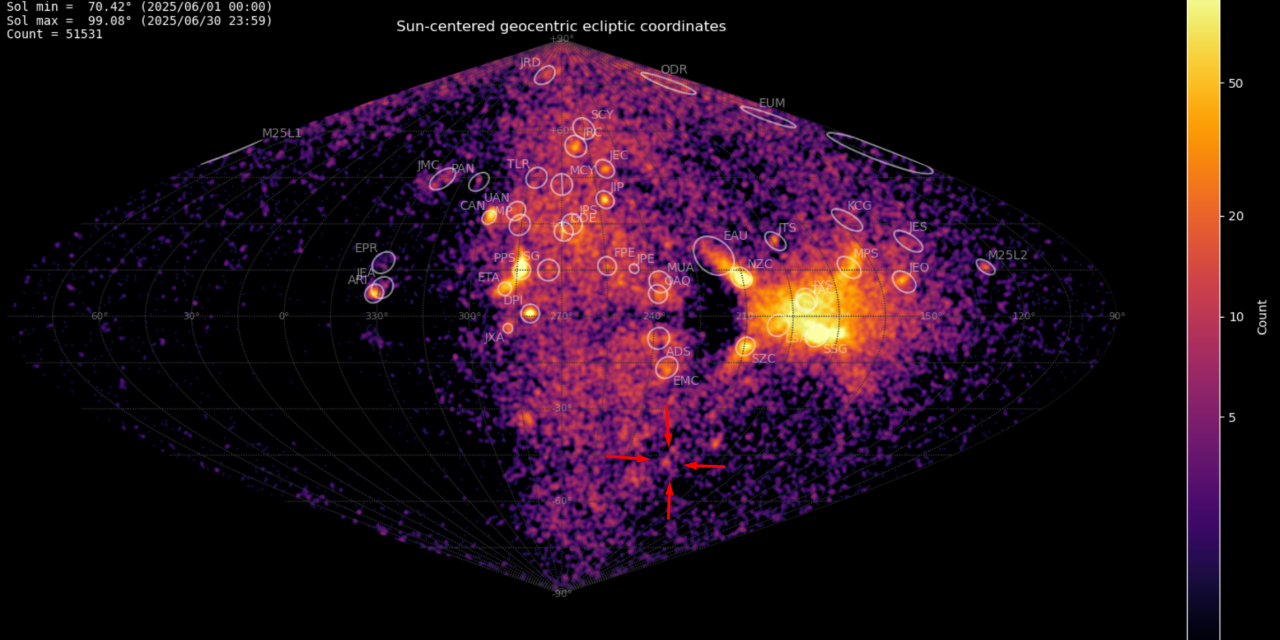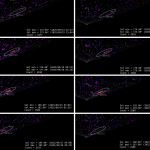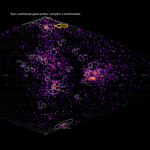by Denis Vida, Damir Šegon and Paul Roggemans
Abstract: A new meteor shower on a long-period comet type orbit (TJ = 0.85) has been detected during June 14–21, 2025 by the Global Meteor Network. Meteors belonging to the new shower were observed between 82° < λʘ < 91° from a radiant at R.A. = 330.0° and Decl.= –63.8° in the constellation of Indus, with a geocentric velocity of 43.8 km/s. The new meteor shower has been listed in the Working List of Meteor Showers under the temporary name-designation: M2025-O2.
Introduction
The GMN radiant map for June 2025 shows a weak concentration of related radiants in the constellation of Indus. 30 meteors of this meteor shower were observed by the Global Meteor Network low-light video cameras on 2025 June 13 – 24 (Figure 1). The shower was independently observed by cameras in two countries (Australia and New Zealand).
The shower had a median geocentric radiant with coordinates R.A. = 330.0°, Decl. = –63.8°, within a circle with a standard deviation of ±1.6° (equinox J2000.0) see Figure 2. The radiant drift in R.A. is +1.62 deg on the sky per degree of solar longitude and +0.23 in Dec., both referenced to λʘ = 85.2° (Figures 3 and 4). The median Sun-centered ecliptic coordinates were λ – λʘ = 219.15°, β = –47.34° (Figure 5). The geocentric velocity was 43.8 ± 0.2 km/s.
All meteors appeared during the solar-longitude interval 82° – 93°, with most events at 16–17 June (around λʘ = 85.5°).
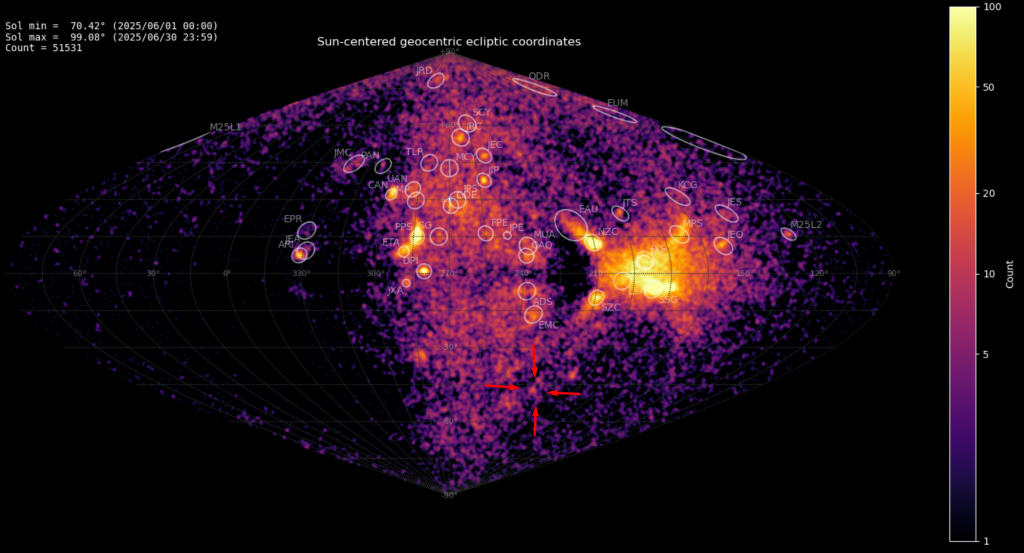
Figure 1 – Heat map with 51531 radiants obtained by the Global Meteor network in June 2025. A weak concentration is visible in Sun-centered geocentric ecliptic coordinates which was identified as a new meteor shower with the temporary identification M2025-O2.
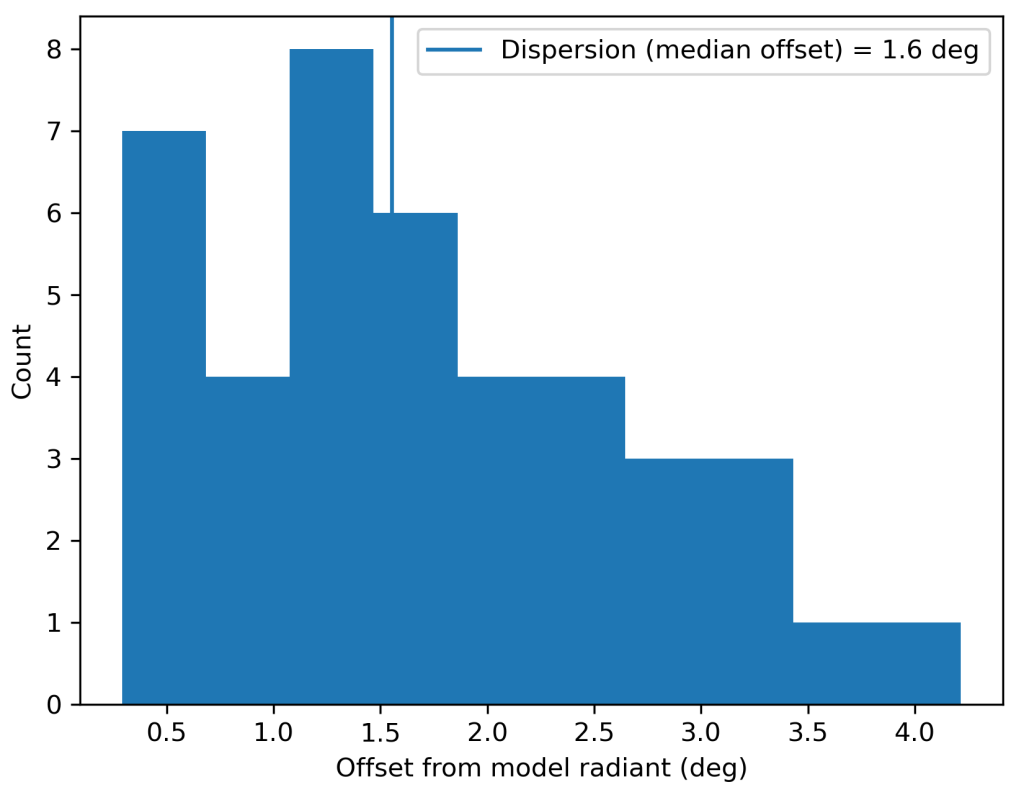
Figure 2 – Dispersion on the radiant position.
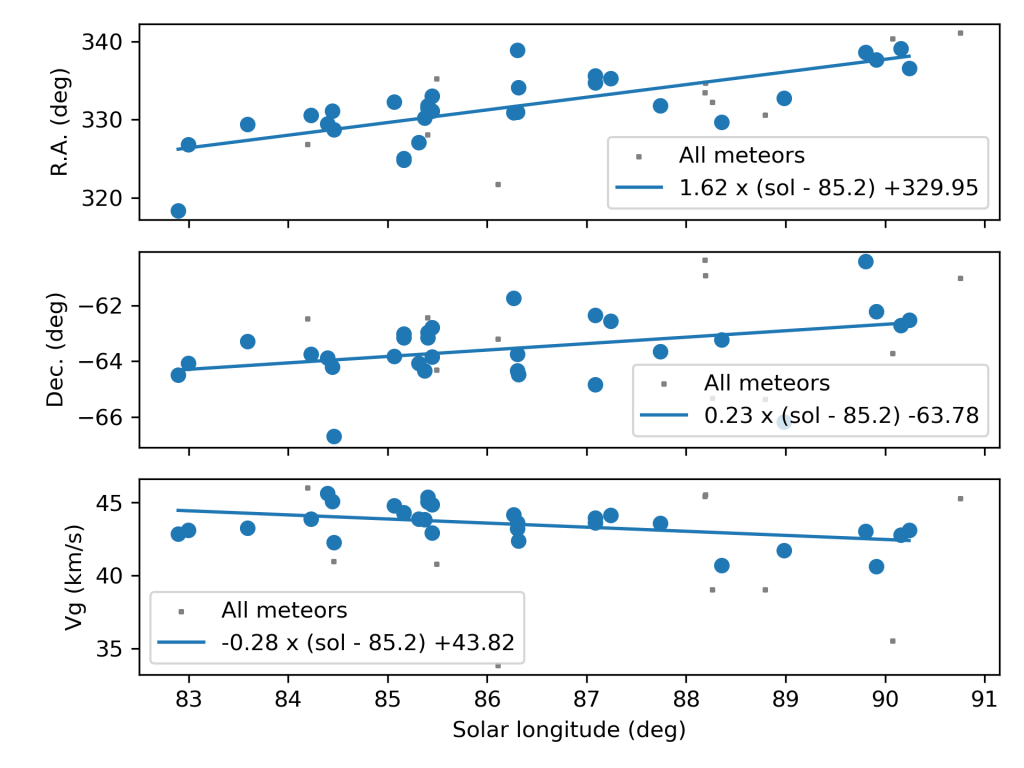
Figure 3 – The radiant drift.
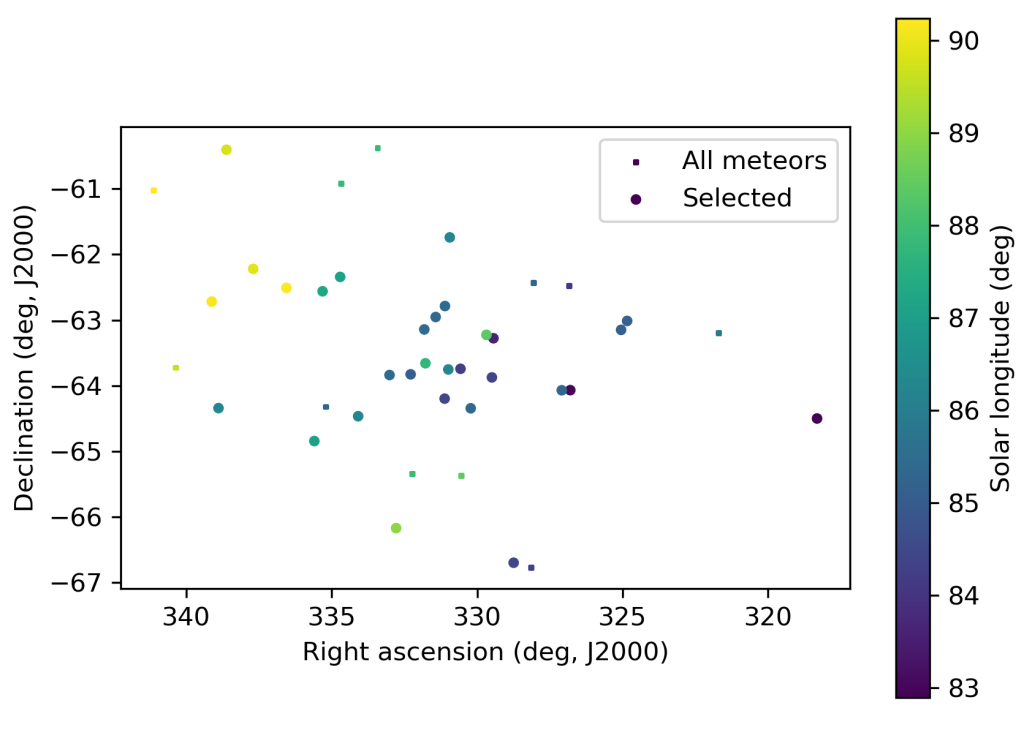
Figure 4 – The radiant distribution during the solar-longitude interval 82° – 91° in equatorial coordinates.
First detection
The GMN shower association criterion assumes that meteors within 1° in solar longitude, within 3° in radiant, and within 10% in geocentric velocity of a shower reference location are members of that shower. Further details about the shower association are explained in Moorhead et al. (2020). This is a rather strict criterion since meteor showers often have a larger dispersion in radiant position, velocity and activity period. Using these meteor shower selection criteria, 30 orbits have been associated with the new shower in the GMN meteor orbit database and the mean orbit has been listed in Table 1. This possible new meteor shower was reported to the IAU MDC and added under the temporary identification 2025-O2.
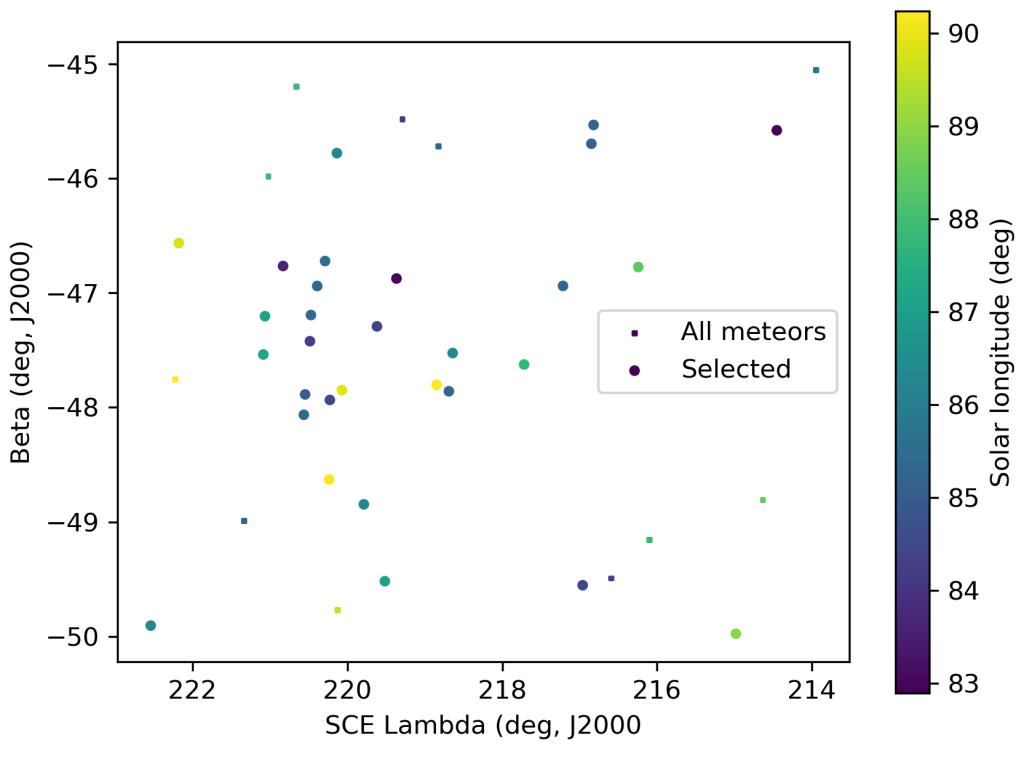
Figure 5 – The radiant distribution during the solar-longitude interval 82° – 91° in Sun centered geocentric ecliptic coordinates.
Another search method
Another method has been applied to check this new meteor shower discovery. The starting point here can be any visually spotted concentration of radiant points or any other indication for the occurrence of similar orbits. The method has been described before (Roggemans et al., 2019). The main difference with the method applied in Section 2 is that three different discrimination criteria are combined in order to have only those orbits which fit different criteria thresholds. The D-criteria that we use are these of Southworth and Hawkins (1963), Drummond (1981) and Jopek (1993) combined. Instead of using a cutoff value for the threshold of the D-criteria these values are considered in different classes with different thresholds of similarity. Depending on the dispersion and the type of orbits, the most appropriate threshold of similarity is selected to locate the best fitting mean orbit as the result of an iterative procedure.
This method resulted in a mean orbit with 53 related orbits that fit within the similarity threshold with DSH < 0.20, DD < 0.08 and DJ < 0.2, recorded 2025 June 13 – 24. The plot of the radiant positions in equatorial coordinates, color coded for different D-criteria thresholds, shows a stretched trail in Right Ascension from about 315° to 345° due to the radiant drift (Figure 6), see also Figure 3.
Looking at the Sun-centered geocentric ecliptic coordinates the radiant drift caused by of the Earth moving on its orbit around the Sun is compensated and a more compact radiant becomes visible (Figure 7). The blue dots with DSH < 0.25, DD < 0.105 and DJ < 0.25 as well as the green dots with DSH < 0.20, DD < 0.08 and DJ < 0.2 display a large dispersion and may include some contamination with sporadics. To reduce the risk of including sporadic orbits, in the second method only the 23 orbits with DSH < 0.10, DD < 0.04 and DJ < 0.10 are considered. Figures 8 and 9 show that these radiants appear on top of an evenly distributed sporadic radiant background. There is another concentration of radiants visible in the upper left corner of Figures 7, 8 and 9. These belong to the poorly known June delta-Pavonids (JDP#835) detected by CAMS in 2014 and 2016 with only 11 orbits (Jenniskens et al., 2018). This shower seems to have displayed possible enhanced activity in 2025 and will be documented in a separate report.
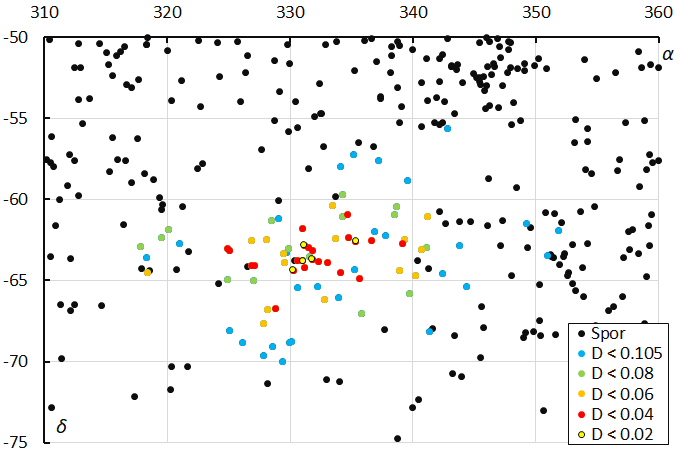
Figure 6 – The radiant distribution during the solar-longitude interval 82° – 93° in equatorial coordinates, color coded for different values of the DD orbit similarity criterion.

Figure 7 – The radiant distribution during the solar-longitude interval 82° – 93° in Sun-centered geocentric ecliptic coordinates, color coded for different values of the DD orbit similarity criterion.
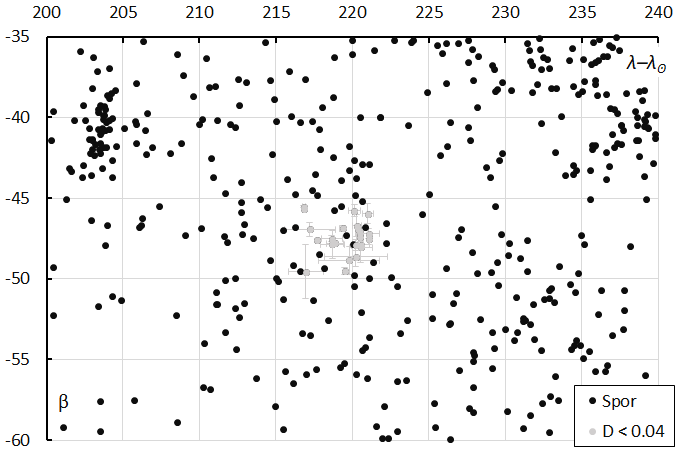
Figure 8 – The sporadic radiants during the solar-longitude interval 82° – 93° in Sun-centered geocentric ecliptic coordinates, with M2025-O2 radiants marked in grey for DD < 0.04.
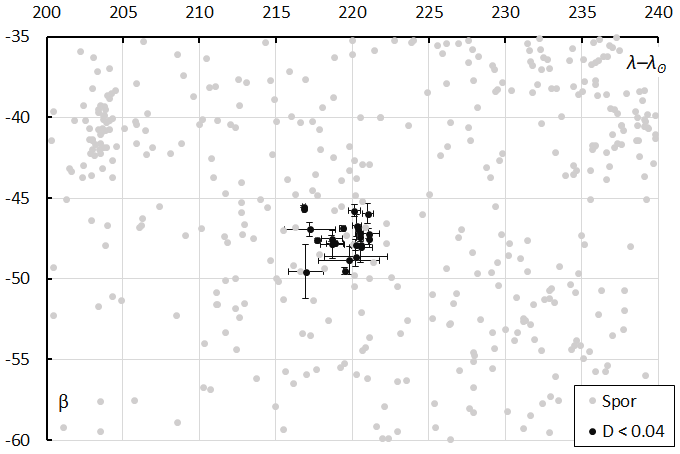
Figure 9 – The M2025-O2 radiants for DD < 0.04 during the solar-longitude interval 82° – 93° in Sun-centered geocentric ecliptic coordinates, with the sporadic radiants marked in grey.
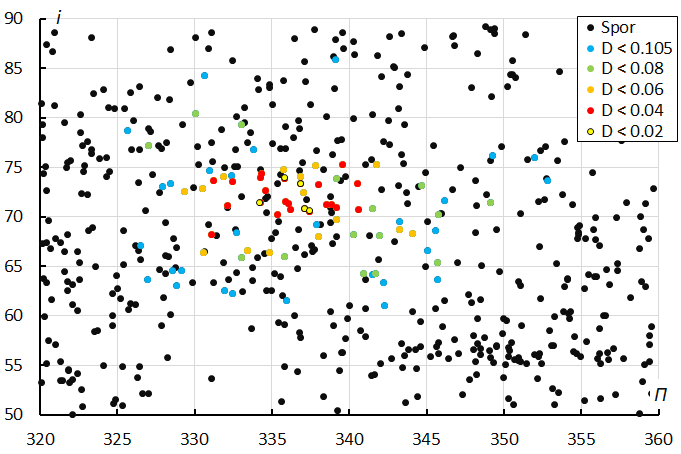
Figure 10 – The diagram of the inclination i against the longitude of perihelion Π color coded for different classes of D criterion threshold.
The diagram with the inclination against the longitude of perihelion (Figure 10) shows quite a lot dispersion on the longitude of perihelion Π.
Orbit and parent body
The Tisserand’s parameter Tj identifies the orbit as of a Halley-type comet in this case with a prograde orbit. Figure 11 visualizes the two orbits found by the two methods. Figure 12 is a close up of the inner solar system with the steep inclined orbit of M2025-O2 and its encounter with the Earth at the ascending node. A parent-body search top 10 includes candidates with a Drummond DD criterion value lower than 0.3 but none of which can be associated with any certainty (Table 2). It would be up to meteoroid stream modelers to reconstruct the dynamic orbit evolution to see if there could be any connection.
Table 1 – Comparing the new meteor shower, derived by two different methods, M2025-O2 the orbital parameters as initially derived, DD < 0.04 were derived from the method described in Section 3.
| M2025-O2 | DD < 0.04 | |
| λʘ (°) | 85.2 | 85.4 |
| λʘb (°) | 82.0 | 83.0 |
| λʘe (°) | 91.0 | 90.2 |
| αg (°) | 330.0 | 331.4 |
| δg (°) | –63.8 | –63.7 |
| Δαg (°) | 1.62 | 1.57 |
| Δδg (°) | 0.23 | 0.32 |
| vg (km/s) | 43.8 | 43.9 |
| λg (°) | 304.35 | 305.7 |
| λg – λʘ (°) | 219.15 | 220.1 |
| βg (°) | –47.34 | –47.5 |
| a (A.U.) | 9.88 | 12.2 |
| q (A.U.) | 0.690 | 0.691 |
| e | 0.930 | 0.943 |
| i (°) | 71.6 | 72.1 |
| ω (°) | 70.3 | 69.9 |
| Ω (°) | 266.2 | 266.1 |
| Π (°) | 336.5 | 336.0 |
| Tj | 0.85 | 0.74 |
| N | 30 | 23 |
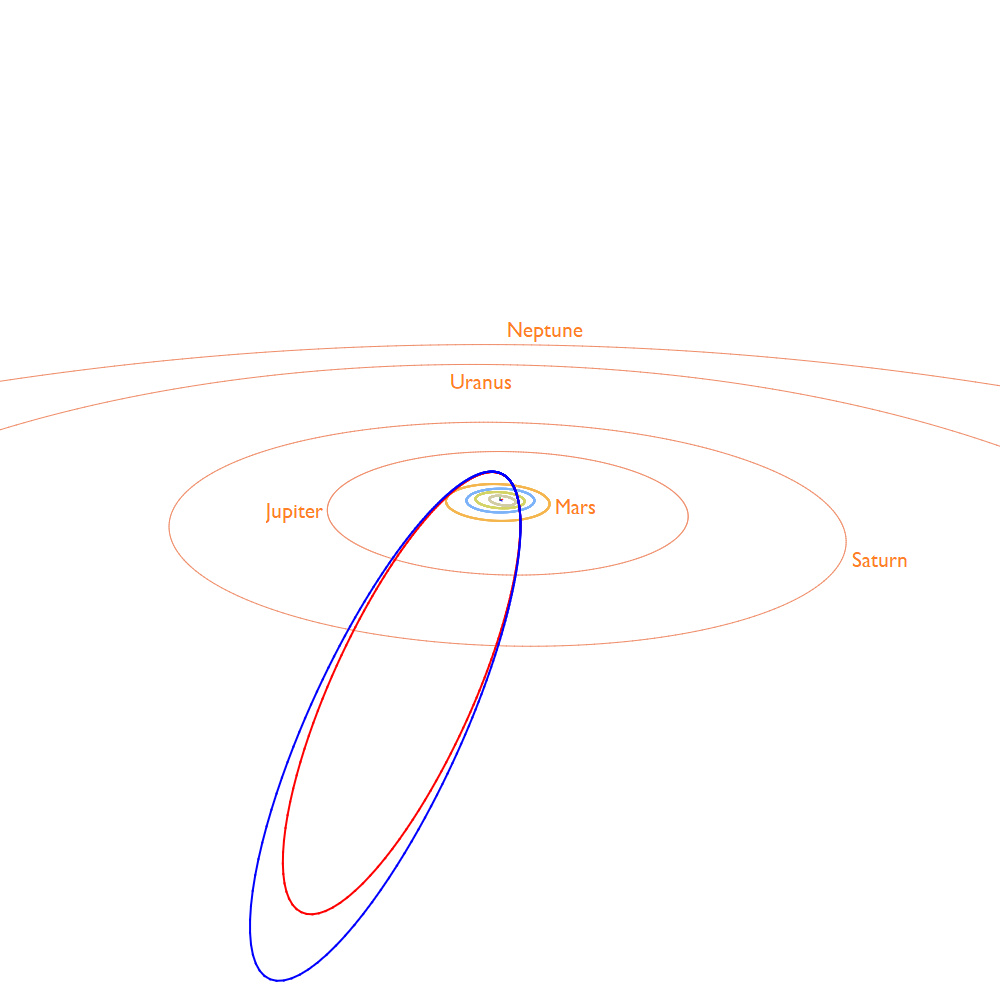
Figure 11 – Comparing the mean orbit based on the shower identification according to the two methods, red is for M2025-O2 and blue for the alternative shower search method with DD < 0.04 in Table 1. (Plotted with the Orbit visualization app provided by Pető Zsolt).
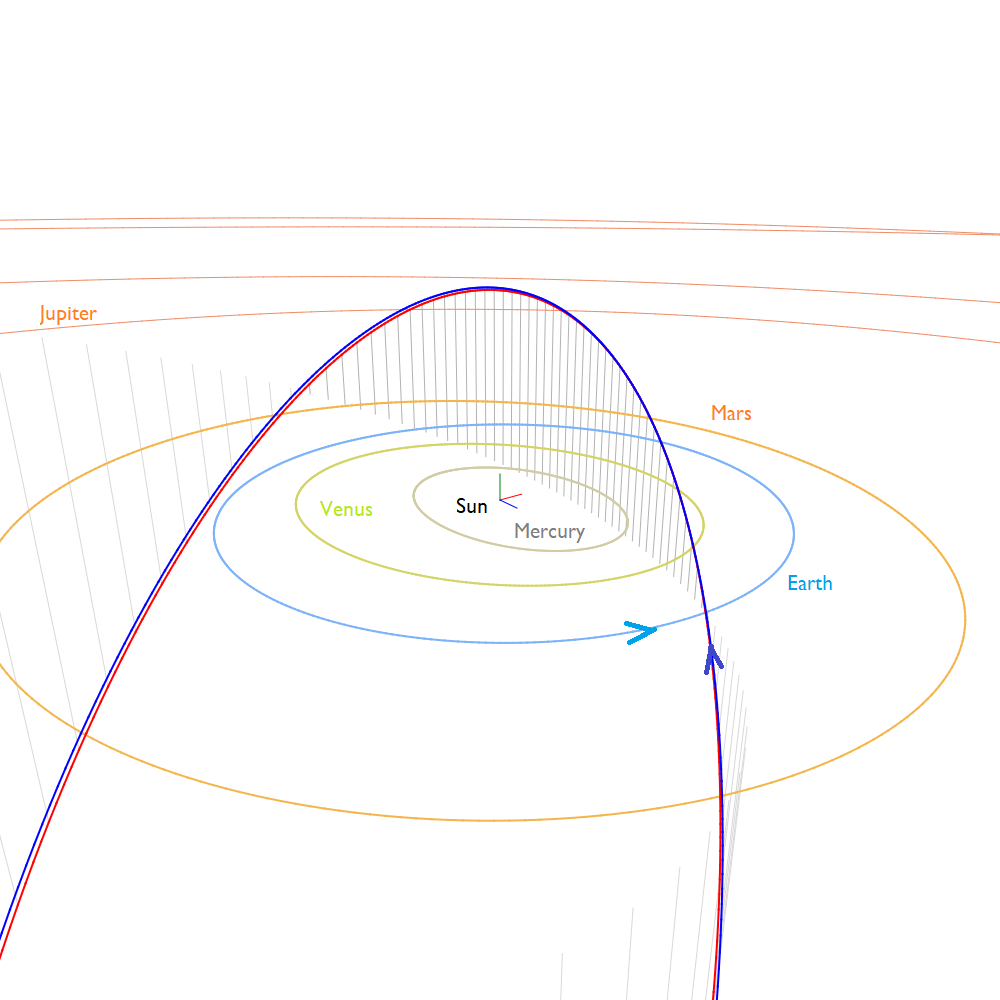
Figure 12 – Comparing the mean orbit based on the shower identification according to two methods, red is for M2025-O2 and blue for the other shower search method with DD < 0.04 in Table 1. With an inclination of 72° the orbit is very steep on the ecliptic plane. (Plotted with the Orbit visualization app provided by Pető Zsolt).
Table 2 – Top ten matches of a search for possible parent bodies with DD < 0.3.
| Name | DD |
| C/1863 G2 (Respighi) | 0.184 |
| 2012 XT134 | 0.213 |
| (311044) 2004 BB103 | 0.231 |
| C/1941 K1 (van Gent) | 0.237 |
| C/1376 M1 | 0.245 |
| C/1883 D1 (Brooks-Swift) | 0.259 |
| C/1898 F1 (Perrine) | 0.262 |
| C/1951 C1 (Pajdusakova) | 0.267 |
| C/1912 R1 (Gale) | 0.275 |
| C/1953 G1 (Mrkos-Honda) | 0.276 |
This possible new meteor shower is very likely an old dust trail, dispersed with a rather large spread in the longitude of perihelion Π and with a barely detectable weak activity. The final mean orbits obtained via the two independent meteor shower search methods are in very good agreement. The first meteor shower search includes three orbits that failed to fit the DD < 0.08 criteria in the second method, while the second method includes eleven orbits that were ignored by the first search method. The differences between both methods occurred mainly at the end of the detected activity period and concern outliers that could be sporadic contamination. In total 27 orbits were in common by both methods. Of the 23 orbits that fit the DD < 0.04 threshold in the second method, 22 were in common with the first search method.
Activity in past years
A search in older GMN orbit data resulted in two possible orbits with DD < 0.08 in 2022, 17 in 2023 of which five with DD < 0.04 and 48 orbits in 2024 of which six with DD < 0.04. No other meteor orbit datasets were checked because of the lack of coverage at the southern hemisphere in the EDMOND and SonotaCo Net meteor orbit datasets.
Conclusion
The discovery of a new meteor shower with a radiant in the constellation of Indus based on thirty meteors during 2025 June 13–24 has been confirmed by using two independent meteor shower search methods. The resulting mean orbits for both search methods are in good agreement. All meteors appeared during the solar-longitude interval 82° – 93°, with most events around 16–17 June (λʘ = 85.2°). Orbits of this meteor shower were detected in 2023 and 2024, but the number of events in previous years remained below the detection threshold.
Acknowledgment
This report is based on the data of the Global Meteor Network (Vida et al., 2020a; 2020b; 2021) which is released under the CC BY 4.0 license. We thank all 825 participants in the Global Meteor Network project for their contribution and perseverance. A list with the names of the volunteers who contribute to GMN has been published in the 2024 annual report (Roggemans et al., 2025).
References
Drummond J. D. (1981). “A test of comet and meteor shower associations”. Icarus, 45, 545–553.
Jenniskens P., Baggaley J., Crumpton I., Aldous P., Pokorny P., Janches D., Gural P. S., Samuels D., Albers J., Howell A., Johannink C., Breukers M., Odeh M., Moskovitz N., Collison J., Ganju S. (2018). “A survey of southern hemisphere meteor showers”. Planetary and Space Science, 154, 21–29.
Jopek T. J. (1993). “Remarks on the meteor orbital similarity D-criterion”. Icarus, 106, 603–607.
Jopek T. J., Rudawska R. and Pretka-Ziomek H. (2006). “Calculation of the mean orbit of a meteoroid stream”. Monthly Notices of the Royal Astronomical Society, 371, 1367–1372.
Moorhead A. V., Clements T. D., Vida D. (2020). “Realistic gravitational focusing of meteoroid streams”. Monthly Notices of the Royal Astronomical Society, 494, 2982–2994.
Roggemans P., Johannink C. and Campbell-Burns P. (2019a). “October Ursae Majorids (OCU#333)”. eMetN Meteor Journal, 4, 55–64.
Roggemans P., Campbell-Burns P., Kalina M., McIntyre M., Scott J. M., Šegon D., Vida D. (2025). “Global Meteor Network report 2024”. eMetN Meteor Journal, 10, 67–101.
Southworth R. B. and Hawkins G. S. (1963). “Statistics of meteor streams”. Smithsonian Contributions to Astrophysics, 7, 261–285.
Vida D., Gural P., Brown P., Campbell-Brown M., Wiegert P. (2020a). “Estimating trajectories of meteors: an observational Monte Carlo approach – I. Theory”. Monthly Notices of the Royal Astronomical Society, 491, 2688–2705.
Vida D., Gural P., Brown P., Campbell-Brown M., Wiegert P. (2020b). “Estimating trajectories of meteors: an observational Monte Carlo approach – II. Results”. Monthly Notices of the Royal Astronomical Society, 491, 3996–4011.
Vida D., Šegon D., Gural P. S., Brown P. G., McIntyre M. J. M., Dijkema T. J., Pavletić L., Kukić P., Mazur M. J., Eschman P., Roggemans P., Merlak A., Zubrović D. (2021). “The Global Meteor Network – Methodology and first results”. Monthly Notices of the Royal Astronomical Society, 506, 5046–5074.

